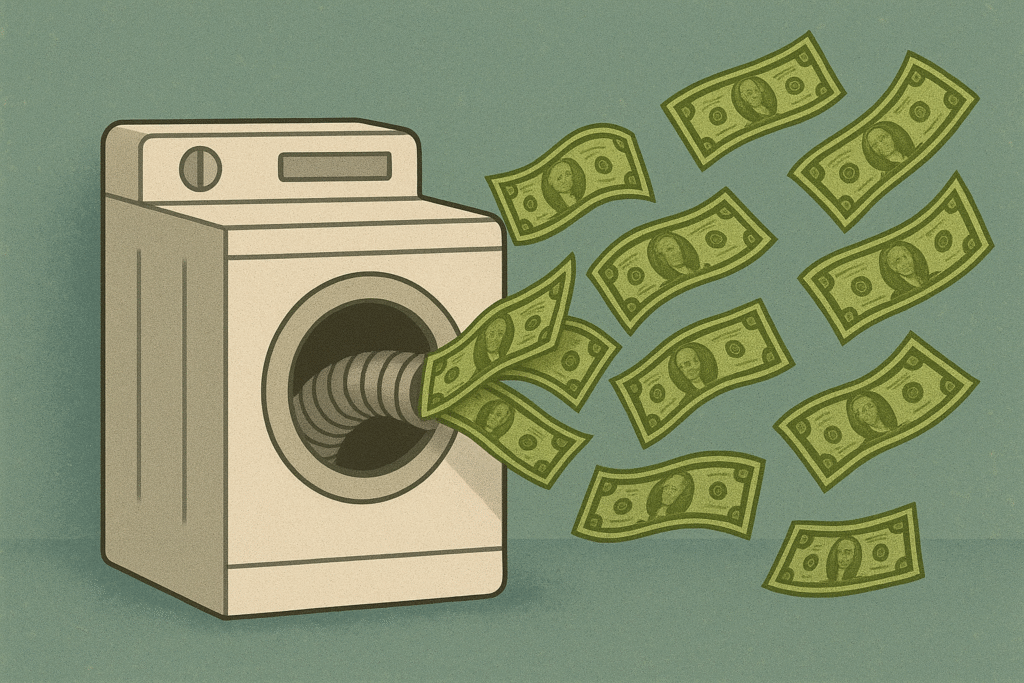
“Last month, my friend Sarah got hit with a $400 electric bill. She called me over, convinced her meter was broken. After some detective work, we figured out that her dryer had been running twice as long to get clothes dry. I asked her when was the last time she cleaned her dryer vent? She said “Wait, you’re supposed to clean those?” “
This was an actually conversation I had with a customer with many alike it. If you’ve had a similar exchange you’re not alone. Most people know to clean the lint trap after every load, but that external vent? It’s out of sight, out of mind until it starts costing you serious money.
Your Energy Bills Are Quietly Creeping Up
Here’s what happens when lint builds up in your dryer vent: your dryer has to work harder and longer to push hot, moist air outside. What used to be a 45-minute cycle turns into an hour and a half. Sometimes you’re running loads twice just to get everything dry.
The numbers are pretty eye-opening. Because dryers need a ton more energy then most appliances, a clogged dryer vent can increase your energy consumption by 25-30%. For the average household spending about $100 monthly on electricity, that’s an extra $25-30 every month. Over a year, you’re looking at $300-360 in unnecessary costs.
I figured this to be true when my parents moved in to their new home years ago. The previous owners clearly hadn’t touched the dryer vent in years. My Dad was flipping out when he got the first electric bill. I guess we both haven’t really noticed and were sort of on auto pilot with the new move, but the thing was taking forever to dry. Once I had the vent professionally cleaned, his energy bill $40 a month! True story
The Repair Costs Nobody Talks About
But the energy bills are just the tip of the iceberg. When your dryer struggles against blocked airflow, it puts massive strain on the internal components.
The heating element works overtime trying to compensate for poor ventilation. These typically last 10-15 years with normal use, but in a poorly vented dryer, you might be replacing them every 3-5 years at $150-200 a pop.
The blower motor is another casualty. It’s designed to move air efficiently, not fight through inches of compressed lint. When it burns out – and it will – you’re looking at $200-300 for parts and labor.
And then there’s the control boards. All that extra heat and strain can fry the electronic components. My appliance repair guy tells me he sees way more control board failures in homes with dirty vents. That’s a $250-400 repair, easy.
The Big Picture: What This Really Costs You
Let’s do some quick math on what ignoring your dryer vent actually costs:
- Extra energy costs: $300-360 per year
- Premature heating element replacement: $150-200 every few years instead of every 10-15
- Blower motor failure: $200-300 repair
- Potential control board issues: $250-400 repair
It’s Not Just About the Money
While we’re talking dollars and cents here, there’s something more important at stake. The National Fire Protection Association reports over 13,000 home fires caused by dryers each year, with failure to clean being the leading factor.
That lint buildup isn’t just costing you money – it’s a genuine fire hazard. When airflow is restricted, temperatures inside the vent can reach dangerous levels. All it takes is one spark.
The Bottom Line
Look, I get it. Dryer vent maintenance isn’t exactly exciting. But neither is getting slammed with high energy bills or facing expensive repairs that could have been prevented.
The math is pretty straightforward: spend a little on regular maintenance, or spend a lot more on the consequences. Most homeowners who start paying attention to their dryer vents are shocked by how much money they save.
Sarah, by the way, now has a reminder in her phone to check her dryer vent every year. Her energy bills went back to normal, and she hasn’t had a single dryer issue since. Sometimes the simplest maintenance tasks make the biggest difference.
Your wallet – and your peace of mind – will thank you for staying on top of this one.
